IN THE UNITED STATES PATENT AND TRADEMARK OFFICE
Utility Patent Application (Provisional)
Lunar Ice Collection System
Marcus van Bavel, Austin Texas
SPECIFICATION
CROSS-REFERENCE TO RELATED APPLICATIONS
Not Applicable
STATEMENT REGARDING FEDERALLY SPONSORED RESEARCH OR
DEVELOPMENT
Not Applicable
REFERENCE TO SEQUENCE LISTING, A TABLE, OR A COMPUTER PROGRAM
LISTING COMPACT DISK APPENDIX
Not Applicable
BACKGROUND OF THE INVENTION
The present invention is related generally to systems for extracting materials from planetary surfaces and using the materials to support the exploration and settlement of space. More particularly, the present invention is related to space propulsion, automatic landing of spacecraft, Lunar ice deposits, vacuum pumping, orbiting fuel depots, and electrolysis of water for propellant in space.. The present invention is also related to systems for space solar power, automated rendezvous and docking of spacecraft, fuel cells, and automatic assembly of large space structures.
The state of the art for resource mining on planetary surfaces provides for the landing of a robotic spacecraft on the planet surface, the scooping and collection of solid materials into a container on the robotic spacecraft, and launch of the container back into orbit. However these methods are inefficient and do not generate more propellant than they use. The present invention provides an improved and simplified method for collecting volatile materials including water ice from the Lunar surface using only a dome-shaped shell, and then brings the water ice to a place where it can be converted to propellant with Solar energy. The system in its preferred embodiment produces roughly three times more propellant than it uses, and can also produce electric power and drinking water.
SUMMARY OF THE INVENTION
The present invention provides a robotic system to collect volatile materials comprising water ice or other icy materials from a planetary surface. The preferred embodiment of the invention collects water ice from the Moon’s permanently shadowed regions. Accordingly, in this embodiment of the invention, a hydrogen-oxygen propelled Moon lander is launched with a two-stage rocket into Earth orbit along with propellant tanks and a stack of lightweight hexagonal or pentagonal-shaped panels. While in Earth orbit, the panels assemble themselves into a geodesic dome. Each panel is equipped with a simple computer guidance system that uses radio proximity detectors and cold-gas thrusters to position itself in zero gravity. The panels rendezvous and dock with each other. Magnets on the edges of the panels grip each other and latching pins driven by wax motors attach and lock the panels to themselves. Once the dome is completed into a single large structure of approximately 25 meters in diameter, the second stage engine of the rocket fires again to place the lander in low lunar orbit. The lander then descends and lands on one of the Moon’s polar regions where there is ice on the surface. In the process of landing and after landing, the lander’s engine heats up the ice at the surface directly underneath it, causing the ice to sublimate, and the dome traps the sublimated water vapor underneath the lander. The exterior of the dome is exposed to the cold of space and is within the Moon’s shadow, therefore the temperature of the dome will drop well below the freezing point of water. Some time after the lander has stopped firing, the water vapor is allowed to cool and part of it will form ice on the underside of the dome. On Earth this process is known as cryopumping where a cold plate cooled with liquid helium is exposed to a partially evacuated chamber and the remaining air molecules stick to the plate and a high vacuum (less than 10-4 Torr) is obtained. Cryopumps are used for particle accelerators, space environment testing chambers, and other applications where a high vacuum is needed. In the present invention, the underside of the dome provides the cold plate and it is cooled by the exposure of its top surface to space in the absence of sunlight. In another embodiment of the invention, a liquid helium cooling system actively cools the dome and radiates the heat through an attached radiator.
In another aspect of the invention, a labyrinth of structures on the underside surface of the dome provides a large area to collect and trap the water as it crystallizes back into ice. The labyrinth holds the ice and prevents it from breaking off when the dome is launched back into space.
In another aspect of the invention, before re-crystallization some or all of the trapped water vapor is pumped with a vacuum pump into a small collection tank positioned over the top of the lander. This method is useful for measuring the amount of water vapor trapped by the dome. The collected water vapor is heated by the pumping, and while it remains a gas inside the collection tank, the mass of the water can be measured indirectly through the use of the ideal gas law and knowing the temperature and pressure inside the tank.
In another aspect of the invention, pellets of radioactive material are used inside the lander to keep the electronics, pumps and propellant valves warm enough to operate while the lander is stationed within the Lunar crater and exposed to extreme cold.
In another aspect of the invention, the lander will launch itself back into orbit and rendezvous with a second lander of similar design. The two landers will join their domes together to create an enclosed space where the frozen ice attached to the underside of the domes can be heated by solar energy, sublimated into water vapor and collected with a vacuum pump driven by solar electric power.
In another aspect of the invention, the water is transferred to a fuel depot which has previously been placed into orbit. The fuel depot collects water from a plurality of landers and stores the water for later conversion via electrolysis into hydrogen and oxygen propellant. Part of the produced propellant, about 30%, is pumped into the lander’s hydrogen and oxygen tanks while it is docked. This provides the propellant for the lander to return to the Lunar surface to collect more ice. In the preferred embodiment of the invention, the landers are reusable and they always collect significantly more water ice than is used as propellant to land and take off from the Moon, allowing the system to operate continuously and always produce more water than it needs to operate.
In another aspect of the invention, the solar panels and radiators of the fuel depot are self-assembled in Earth orbit using the same system that assembles the lander domes. In this way all the components of the system are less than 4 meters in diameter and can be launched in rockets that have 5 meter diameter fairings.
In another aspect of the invention, the lander dome also serves as a solar shade for the fuel depot, allowing the hydrogen and oxygen propellant to be stored for a very long time in orbit with a minimum of cooling or added insulation. The solar shade is positioned by the fuel depot’s guidance system to shade the fuel depot’s propellant storage tanks but without shading the solar array.
In another aspect of the invention, instead of returning to Lunar orbit, the lander travels from the Moon’s polar region to another part of the Moon which receives a significant amount of sunlight. A depot on the surface of the Moon is used instead of one in orbit. The lander travels by rocket from the permanently shadowed crater to a position on the Moon that is close to the surface depot. In this embodiment of the invention, the distance from the landing zone to the depot is approximately one kilometer. A battery-powered rover approaches the lander, goes into the interior of the dome through a doorway, connects a water line to the lander and then pumps the water vapor from the lander into its own tanks. If there is ice on the underside of the lander it is allowed to sublimate when heated with sunlight and then pumped into the rover’s tank. The rover then carries the water to the fuel depot. This method is used for water depots that are required for human habitation, or for other uses on the surface of the Moon. In this embodiment of the invention enough hydrogen and oxygen is produced during the Lunar day to provide propellant for the landers. Also in this embodiment of the invention the depot has fuel cells that can convert stored propellant into electric power during the Lunar night.
In a further aspect of the invention, the structural parts of the lunar ice mining system are constructed in zero gravity by self-assembling geometric panels. Each panel is a flat structure comprised of carbon composite sheets joined together with a carbon composite honeycomb or accordion-fold joining the two sides together. This makes a hollow structural panel that can support 100 times its own weight, and is thick enough to house the control system and thrusters for the panel. The panel contains in its interior the sensors, gas thrusters, and electronic control system necessary to move the panels through space in zero gravity, rendezvous and dock with a swarm of other panels, and permanently join the swarm of panels into a large structure. In this embodiment, the structures to be assembled are the geodesic domes used to collect the lunar ice, and the solar panels of the fuel depot. The same assembly system can also be used to join other components of the system that are launched separately. Soon after launch but before landing on the Moon, the panels are released into orbit from the upper stage rocket , and use their gas thrusters to stay in close formation and assemble together. Radio proximity sensors on each panel communicate with each other and measure the distance to each other with 10 cm accuracy to determine the relative distance and attitude of each panel to each other. Solar electric cells power the control system. Digital cameras and target dots painted on the panels allow the panels to rendezvous and dock to each other with high precision in the final moments of docking. Permanent magnets draw panels together and locking pins lock the edges of the panel together and create a high-strength joint. A two-way digital radio communicates between each panel and the upper stage of the rocket. The upper stage rocket provides for communication and monitoring of the assembly process to Earth-based controllers or to astronauts on a nearby space station. Once the structure is completed the panels may provide solar electric power, maneuvering thrust, or radiative cooling to the lunar lander or fuel depot for orbital or surface-based operations.
BRIEF DESCRIPTION OF THE DRAWINGS
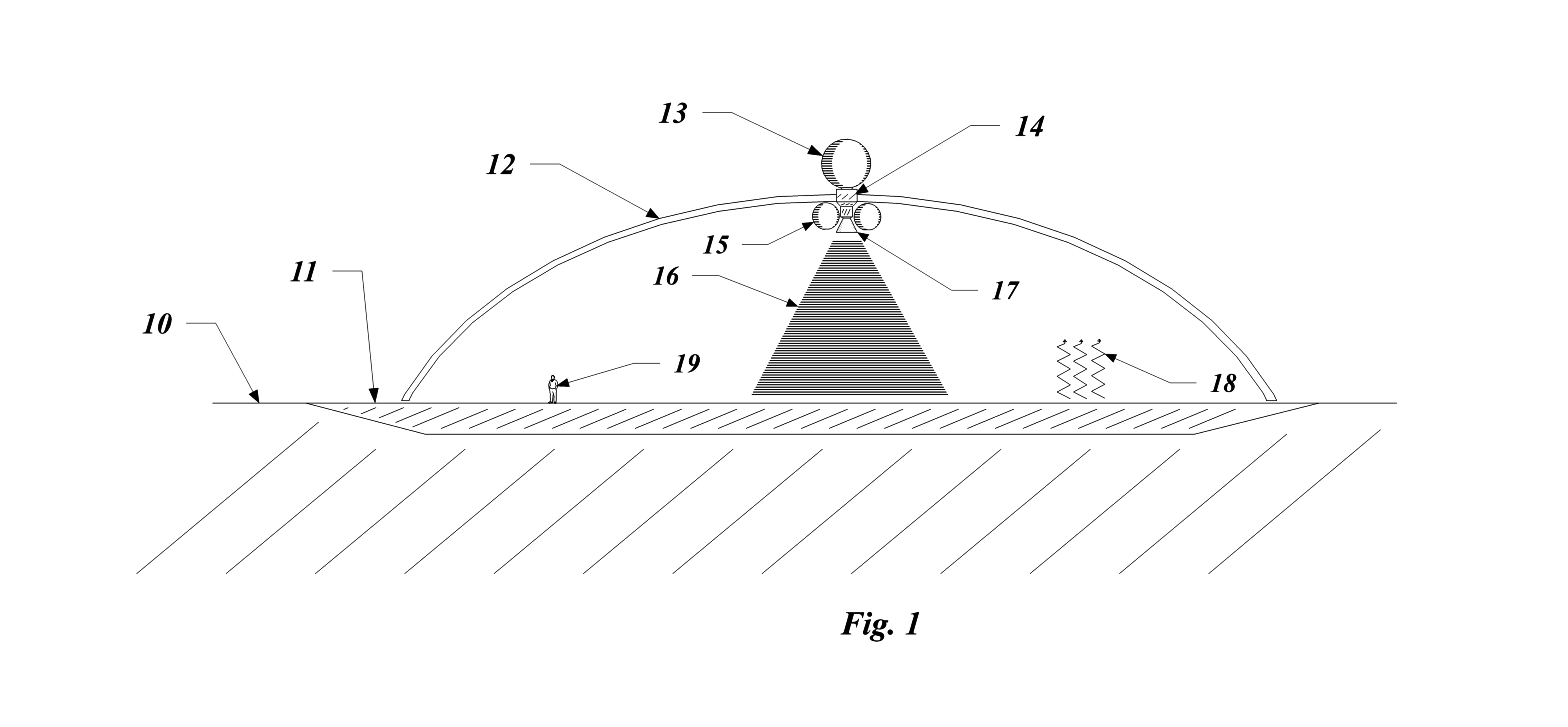 Fig. 1 shows the Lunar lander on the surface of the Moon with the dome in cross-section.
Fig. 1 shows the Lunar lander on the surface of the Moon with the dome in cross-section.
 Fig. 2 shows the lander with the dome in cross-section when it is docked with another lander in low Lunar orbit.
Fig. 2 shows the lander with the dome in cross-section when it is docked with another lander in low Lunar orbit.
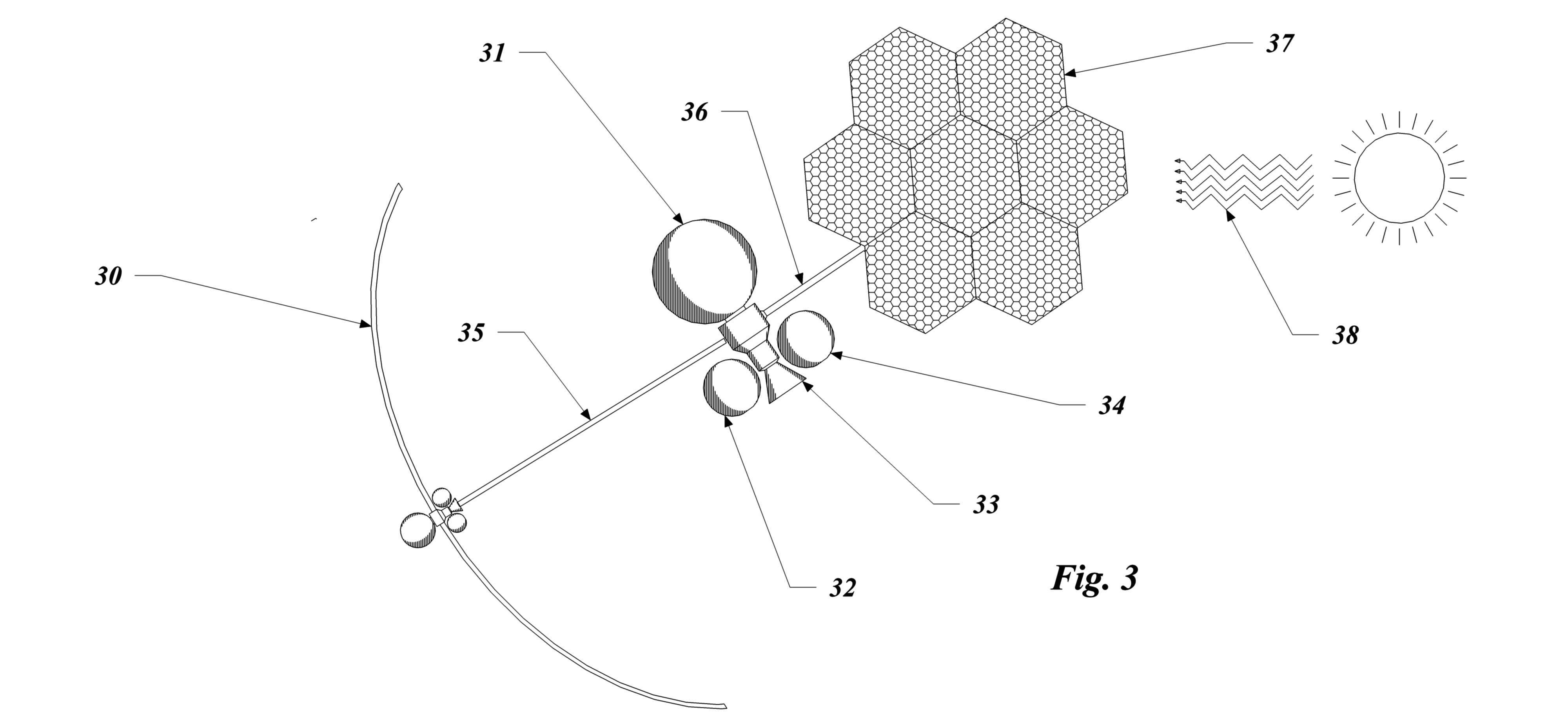 Fig 3 shows the orbiting fuel depot with a docked lander and the depot storage tanks and solar electric panels.
Fig 3 shows the orbiting fuel depot with a docked lander and the depot storage tanks and solar electric panels.
 Fig 4 shows the fuel depot on the surface of the moon and a returning lander.
Fig 4 shows the fuel depot on the surface of the moon and a returning lander.
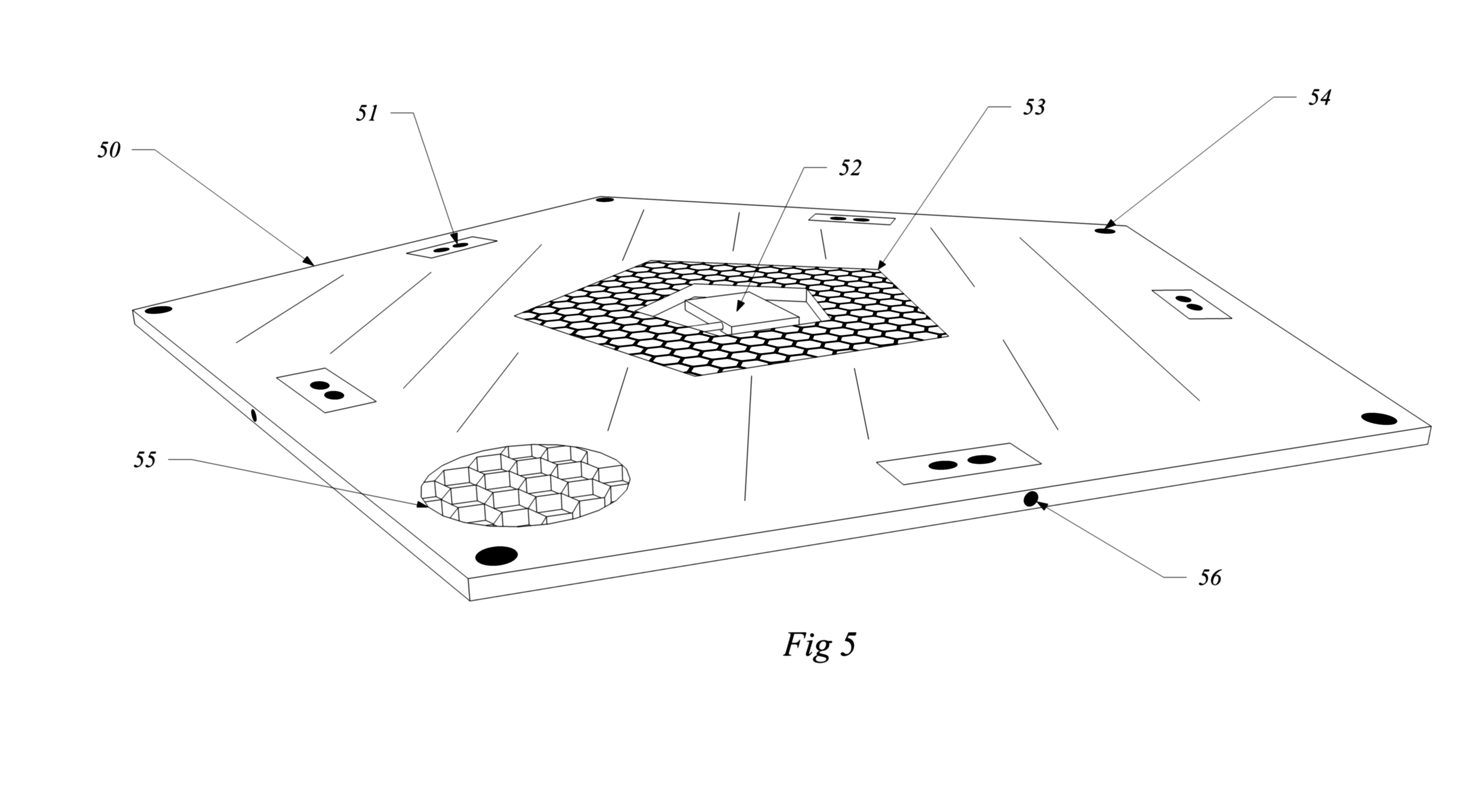 Fig. 5 shows in perspective a lightweight pentagonal structural panel with solar electric cells, cameras, radio proximity detectors, gas thrusters and control system.
Fig. 5 shows in perspective a lightweight pentagonal structural panel with solar electric cells, cameras, radio proximity detectors, gas thrusters and control system.
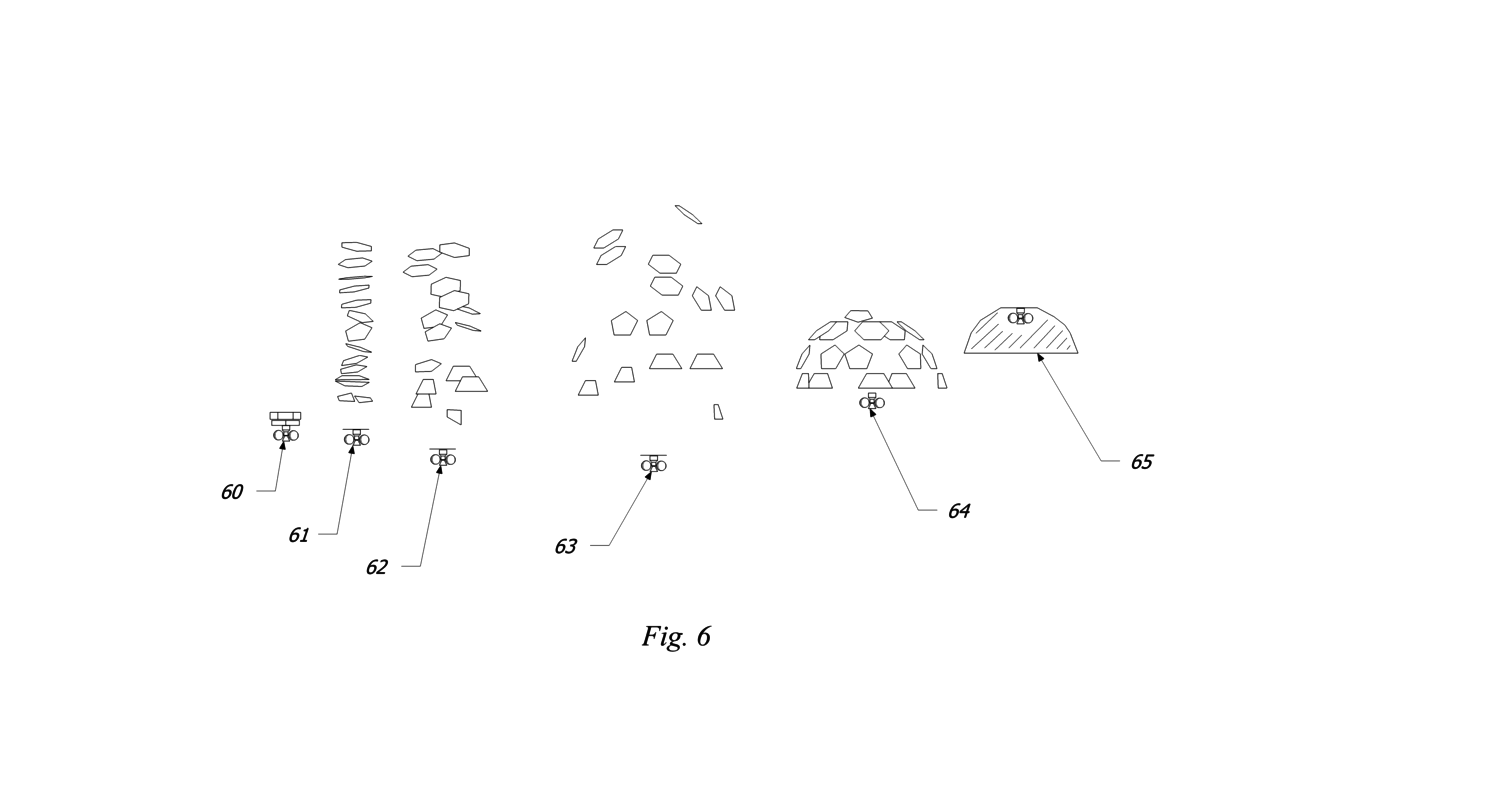 Fig. 6 shows the assembly sequence for a large geodesic dome in low Earth orbit constructed for later use on the Lunar surface.
Fig. 6 shows the assembly sequence for a large geodesic dome in low Earth orbit constructed for later use on the Lunar surface.
DETAILED DESCRIPTION OF THE INVENTION
The present invention will be more completely understood through the following detailed description which should be read in conjunction with the attached drawings in which similar reference numbers indicate similar structures.
In Fig. 1, the invention is used as a Lunar lander. A large, dome-shaped shell 12 attached to a Lunar lander comprised of rocket engine 17, propellant tanks 15, water collection tank 13 and control system 14 lands on the surface of the Moon 10 in the permanently shadowed regions of the Moon which contain water ice 11 near the surface. The control system 14 uses ground-looking radar or other method to choose a flat landing spot free of large rocks and uses the blast and heat from the rocket engine 17 to clear and smooth out the surface. For scale a human figure is shown 19, but the system is entirely automated and no human presence is required.
The heat 16 from the rocket engine 17 impinges on the ice 11, and causes the ice to sublimate, producing water vapor 18. The water vapor produced by the heat is pumped through the engine into the collection tank 13. Or in a further embodiment of the invention, the water vapor is allowed to form ice on the underside of the dome 12. In a further embodiment of the invention, the engine repeatedly fires in short bursts to create enough heat for the ice to sublimate but not enough to heat the underside of the dome. Radioactive heaters in the lander 14 keep the lander’s control system warm enough to operate in the cold environment. In a further embodiment of the invention, after collecting the water vapor and ice the rocket engine 17 fires again to launch the dome back into Lunar orbit.
In a further embodiment of the invention, the lower edge of the dome 12 is constructed of a soft, conformable material comprised of a rubbery material or a partially inflated airbag, and coated with a slick material comprised of teflon or other non-stick plastic coating. The conformable material improves the seal of the dome against the surface to prevent air from leaking out. Also flexing of the material will break off ice that may form and prevent the lander from taking off. The invention does not require a perfect seal from outside space, only that the path of water vapor atoms is long enough to cause a significant number of them to impinge and stick on the underside of the dome before escaping. In a further embodiment of the invention, a labyrinth on the underside of the dome 12 is provided to trap water molecules long enough for them to form ice and prevent the ice from breaking off when the lander is launched back into orbit.
In Fig 2, the lander 20 is joined in Lunar orbit with a second lander of similar construction to form an enclosed chamber. Sunlight 24 impinges on the dome and causes the ice inside the dome to sublimate and form water vapor 25. The water vapor is then pumped through the engine bell 23 into a collection tank 21 with a vacuum pump 22. After pumping the water vapor out, the landers separate.
In the preferred embodiment of the invention, each lander joins in turn with a fuel depot in Lunar orbit or in another part of space, as shown in Fig. 3. In Fig. 3 the lander 30 is shown docked with the fuel depot comprised of a large water tank 31, propellants tanks 32 and 34, maneuvering engine 33 and water/propellant transfer line 35. The fuel depot uses a large solar electric array 37 to collect sunlight 38 and convert it to electricity. The electric power is transmitted through a connection line 36 to the depot. The depot uses electrolysis to separate the water into hydrogen and oxygen gas, compresses and cools the gas into a liquid, and then pumps the liquid propellants into the storage tanks 32 and 34 and to the lander 30 while the lander is docked to the depot. After refueling the lander separates from the depot and returns to the Lunar surface. The propellant line 35 is then available to fuel visiting spacecraft.
In a further aspect of the invention, in Fig 4., the lander travels from the icy crater directly to another part of the Moon 400 instead of going into orbit. In this case the fuel depot is located near a moonbase or other part of the Moon that receives sunlight during the Lunar day. The Lunar surface 400 serves as a landing zone for the Lunar lander 401. The lander arrives with ice from the shadowed region and has stored the ice in its water tank 402. Any ice formed on the underside of the domw is alloed to sublimate and it is pumped into the collection tank. A door provided in the dome 403 opens and admits a lunar rover 405 that has traveled from the fuel depot 409 to park under or nearby the lander’s tank 402. Water is pumped from the collection tank 402 into the rover’s water tanks 405. The rover then returns to the depot 409. At the depot a door 410 is provided for the rover to enter the depot’s shell which serves as a solar shade for the fuel tanks 411. A cooling system uses power from the solar cells 408 or from a fuel cell to keep the hydrogen and oxygen propellants in liquid form. Water is pumped from the rover 405 and separated by electrolysis into propellant and pumped into the propellant tanks 411. Energy from sunlight 407 shines on the solar electric cells 408 and provides electric power to the depot and to the Lunar base. During the night, the propellant is used by fuel cells to produce electric power for the Lunar base and to charge the lunar rover 405 so the system can operate at night. Enough propellant is produced to make the system reusable, to continuously supply power to the Lunar base and produce propellant for the landers to return and collect more water. Water from the depot can also be used by the Lunar base and delivered by the rovers either from the depot or directly from the landers.
In another aspect of the invention the water collection system is constructed in Earth orbit before transport to the Moon. The advantage of space-based construction is that smaller rockets and launch fairings may be used to reduce the overall initial cost of the system and reduce the amount of resources used to transport the system to the Moon. Smaller rockets will be reusable and will be launched more frequently, increasing the reliability of the launch process and lowering costs. Also extremely large fairings capable of containing 25 meter wide payloads do not currently exist. Some construction is space is therefore required and is desirable. The construction must be fully automated and supervised only at a very high level by ground controllers or space station astronauts to reduce operating costs. In this aspect to the invention, a self-construction method is provided for using smart panels with an embedded and autonomous control system and low-weight and low-cost components comprised of solar cells, microprocessors, cameras, radio sensors, gas thrusters and wax motor actuators.
In this aspect to the invention, one of many pentagonal-shaped smart panels is shown in perspective view in Fig. 5. In this embodiment of the invention the panel is comprised of lightweight carbon fiber composite sheets constructed with a spacing material sandwiched between them. The entire panel 50 is constructed in one piece using a 3D printer with continuous carbon fiber thread woven throughout the structure. The carbon fiber composite is capable of supporting 100 times it own weight and can easily withstand launch vibration forces and support the weight of water ice or lunar regolith on its surface. Embedded into the panel are gas thrusters 51, control system electronics revealed in a cutaway view 52, solar electric cells 53, radio proximity sensors 54, cameras 56, and an interior structural material revealed in a cutaway view 55. Once transported into Earth orbit the panel will coordinate with other similar panels, rendezvous and dock its edges against the edges of other panels, and lock together with magnets and actuator pins to create a high-strength joint. The geodesic pattern of construction will evenly distribute loads throughout the assembled panels and create a very high strength dome, hexagonal solar panel, or other-shaped structure, capable of being landed on the Moon intact and relaunched many times. Once its useful life as a Lunar ice collection system is over, the structure can be reused as a shelter by or storage building on the Moon by pushing Lunar dust or regolith on top of it.
Turning to Fig 6. the preferred embodiment of the invention is used to assemble a geodesic dome in zero gravity. The lunar lander 60 and stacks of flat panels similar to that illustrated in Fig 5 are launched into Earth orbit. The stacks separate 61 using the gas thrusters 51. The control system 52 directs the panels into the proper order for assembly 62. The panels are then directed to their approximate positions to attach themselves together 63 and 64. The fully assembled dome with the lunar lander attached is shown in a cutaway view 65.
In another aspect of the invention, the landers and depots of the Lunar ice collection system may be used on the surface of Mars or other planetary surface with an atmosphere. Turning back to Figure 1, in the case of Mars, the lander dome 12 also serves a function as an aeroshell used to brake the lander by friction with the Mars atmosphere, and to reduce the amount of propellant required to land it safely on the planet surface. Also the application of the invention to Mars will require a small rover to scrape the soil off to reveal the layer of ice 11 underneath the surface or to drill holes to the ice layer, and to push soil against the interior edge of the dome 12 to seal it off. Also in the application of the invention to Mars the lander dome 12 includes windows to allow the sun’s rays to pass through the dome and directly heat up the ice 11.
In another aspect to the invention the system may be modified to be used with small asteroids. For an asteroid, a large shell similar to Fig. 2 is constructed in zero gravity from a swarm of smart panels (Fig 5) to completely enclose the object in its original orbit. Small robots are deployed to break up the material so that the volatile components can be exposed to the interior of the shell 20 and heated by the sun’s rays 24. A concentrating mirror or lens may be required if the object is far from the Sun. The sublimated water vapor is collected with a vacuum pump 22. The rest of the system is similar to that described for the orbiting depot shown in Fig 3.
While the foregoing written description of the invention enables one of ordinary skill to make and use what is considered presently to be the best mode thereof, those of ordinary skill will understand and appreciate the existence of variations, combinations, and equivalents of the specific embodiment, method, and examples herein. The invention should therefore not be limited by the above described embodiment, method, and examples, but by all embodiments and methods within the scope and spirit of the invention.
CLAIMS
I claim
1. a system comprising:
a spacecraft with a rocket engine that lands on a planetary surface;
a concave structure attached to said spacecraft for collecting volatile materials
a heat source to sublimate volatile materials on the surface of the planetary surface;
one or more of a plurality of methods to trap the volatile materials in a collection tank or on the underside surface of the concave structure;
a rocket engine to move the spacecraft back into orbit or to another part of the planetary surface if that is required;
a fuel depot in orbit or on the planetery surface with means to transfer the volatile materials to a holding tank and means to convert the volatile materials into rocket propellant;
a method to assemble the parts of the concave structure in zero gravityfrom a swarm of structural components, wherein each structural component has means to control its position and attitude in space, means to sense position of the other structural components, and means to attach itself to other components to form the concave structure.
2. The system of claim 1 wherein the concave structure is a geodesic dome.
ABSTRACT
A robotic system of spacecraft serves to collect volatile materials from a planetary surface and convert the materials to useful forms including water, propellant, and fuel for electric power. In the preferred embodiment, the system is used to collect water ice from the Moon where permanently shadowed areas have large deposits of water ice directly on the surface. A large dome-shaped shell is landed on the ice deposit and the Moon lander engine is used to heat up the ice and allow it to sublimate. The sublimated water vapor is then allowed to cool and re-form ice on the underside of the surface of the dome. Water vapor is pumped into a collection tank. The water is then used either at the Lunar surface or the water is brought up to Lunar orbit where solar energy is used to convert the ice into hydrogen-oxygen rocket propellant for visiting space vehicles. Because the landers are reusable and efficient, the system produces approximately three times more propellant than it needs for the landers to descend and take off from the Moon. The large domes used to collect the ice are constructed in zero gravity from smart panels that use proximity sensors, cameras, actuators, and gas thrusters to assemble themselves from a swarm in space before landing on the Moon. The system can also be used, with modifications, on Mars or with asteroids.

The Lunar Ice Collection Experiment is proposed to demonstrate and evaluate a simple low-cost method to collect Lunar ice from the Moon's surface using a commercial lunar lander and a large dome-shaped enclosure made from a Centaur fuel tank:

All the parts needed to build the experiment are currently in production for the Centaur upper stage, and the lander's own sensors and systems will provide the data for the experiment. Because the experiment takes advantage of existing hardware and instruments, and requires very little software development, it can be flight-ready within one year.
The collection method is to land a large dome-shaped shell within the permanently shadowed regions of the Moon.
The lander's engine will serve as a source of heat to sublimate about 10 kilograms of ice or other volatiles from the landing spot, trap the vapor under the shell, and either pump the water vapor into a collection tank (a Centaur helium tank), or allow it to cool and crystallize underneath the dome's underside surface. In either case the water vapor is expected to reform into ice, but now attached to the lander. The lander will then re-fire its engine and attempt to briefly hover over the surface before touching down a second time. The lander's ground radar, inertial navigation system, and engine sensors will then provide data to determine the mass of the ice collected. Or, if the lander is capable of measuring temperature and pressure within the tank (using either the lander's control system or Centaur helium pressure and temperature sensors) a further demonstration can be performed by estimating the mass using the Ideal Gas Law. For this latter measurement the tank will need to be heated long enough to perform the experiment.
The weight of the dome, collection tank and pump will be 50kg and the maximum diameter 3m.
The amount of ice collected, even if it is zero, and the other lander data, will serve to test this simple method to extract ice and bring it to Lunar orbit, or to a Lunar base elsewhere on the Moon, for later use as propellant or drinking water. The data will also be used to support the development of a self-sustaining Lunar ice collection system where reusable landers with larger attached shells will repeatedly land and take off from the Moon's shadowed regions, and collect 100kg loads of ice for later conversion into propellant.
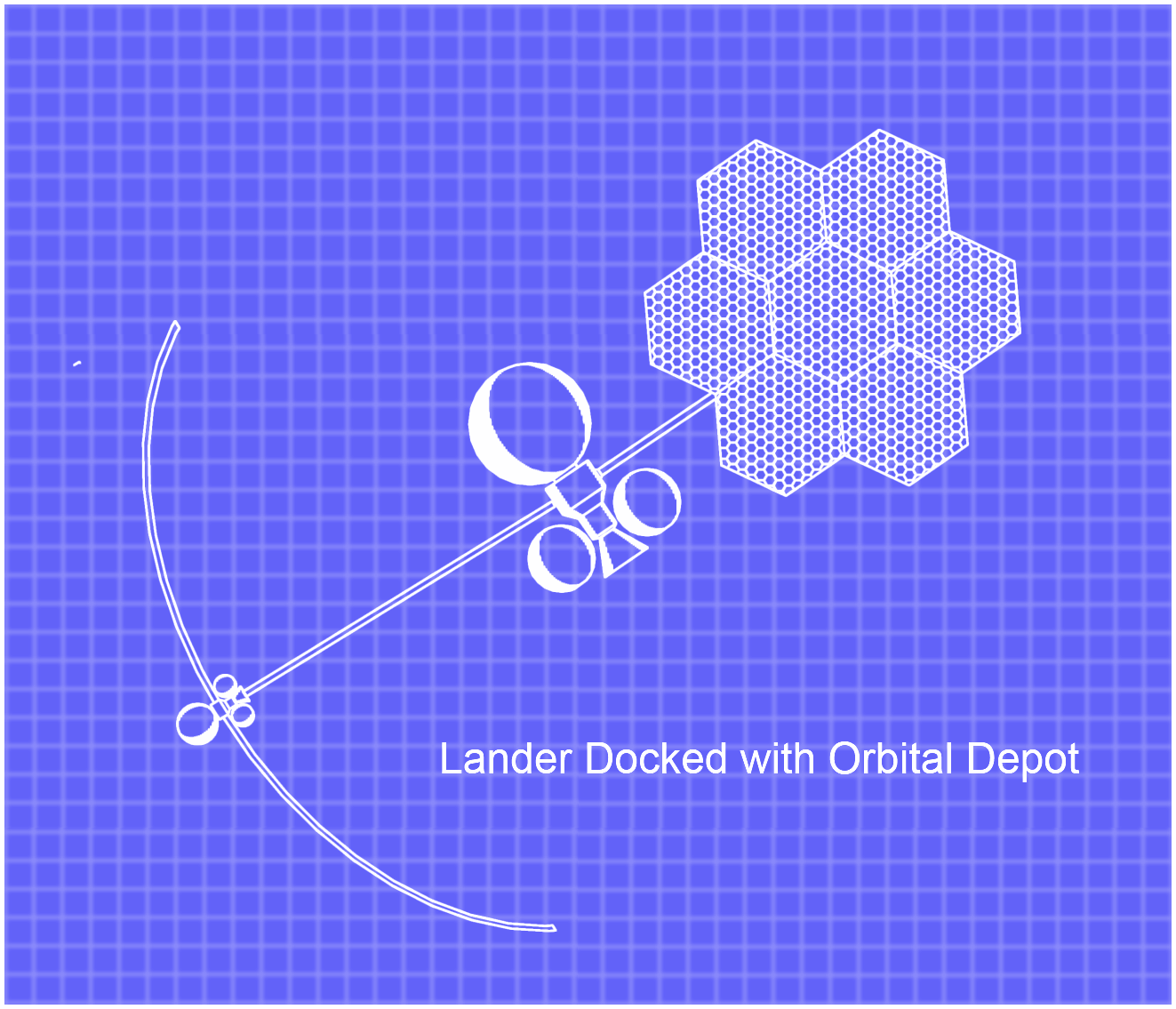
The author can provide details of this larger system which would have carbon-composite domes of 25m in diameter that would self-assemble in Earth orbit, land on the ice and return to orbit with the collected material frozen onto the underside of the dome. In orbit with full sunlight, the ice is trapped, heated and compressed into liquid water. It is electrolysed into hydrogen and oxygen with solar electric power. The lander would then be refueled and return for more ice. This system would use no more than 30% of the collected ice to refuel itself for landings and take-offs and can run a continuous operation for many years. The same 25m domes can be used as aeroshells to land on Mars and collect carbon dioxide or water ice and produce methane fuel on the surface.
The system has advantages over other methods since it does not require complicated long-term operation on the Lunar surface where extreme cold may cause problems with equipment.
The system may also be used in a forward-looking scientific program to extract samples of the Lunar ice and bring them to the future Lunar Orbiting Platform Gateway for analysis by gas spectrometer or other instruments. The astronauts would direct the operation of the landers and operate the electrolysis system on board, in preparation for a fully automated version. The system, once it is proven out, can also provide water and fuel to the LOPG and prove out ISRU methods on both Mars and the Moon. This will serve many of NASA's goals for the exploration of cis-Lunar space, the Lunar surface, the near-Earth asteroids, and Mars.
c. 2018 Marcus van Bavel (US Patent Pending)

The Lunar Ice Collection Experiment is proposed to demonstrate and evaluate a simple low-cost method to collect Lunar ice from the Moon's surface using a commercial lunar lander and a large dome-shaped enclosure made from a Centaur fuel tank:

All the parts needed to build the experiment are currently in production for the Centaur upper stage, and the lander's own sensors and systems will provide the data for the experiment. Because the experiment takes advantage of existing hardware and instruments, and requires very little software development, it can be flight-ready within one year.
The collection method is to land a large dome-shaped shell within the permanently shadowed regions of the Moon.
The lander's engine will serve as a source of heat to sublimate about 10 kilograms of ice or other volatiles from the landing spot, trap the vapor under the shell, and either pump the water vapor into a collection tank (a Centaur helium tank), or allow it to cool and crystallize underneath the dome's underside surface. In either case the water vapor is expected to reform into ice, but now attached to the lander. The lander will then re-fire its engine and attempt to briefly hover over the surface before touching down a second time. The lander's ground radar, inertial navigation system, and engine sensors will then provide data to determine the mass of the ice collected. Or, if the lander is capable of measuring temperature and pressure within the tank (using either the lander's control system or Centaur helium pressure and temperature sensors) a further demonstration can be performed by estimating the mass using the Ideal Gas Law. For this latter measurement the tank will need to be heated long enough to perform the experiment.
The weight of the dome, collection tank and pump will be 50kg and the maximum diameter 3m.
The amount of ice collected, even if it is zero, and the other lander data, will serve to test this simple method to extract ice and bring it to Lunar orbit, or to a Lunar base elsewhere on the Moon, for later use as propellant or drinking water. The data will also be used to support the development of a self-sustaining Lunar ice collection system where reusable landers with larger attached shells will repeatedly land and take off from the Moon's shadowed regions, and collect 100kg loads of ice for later conversion into propellant.
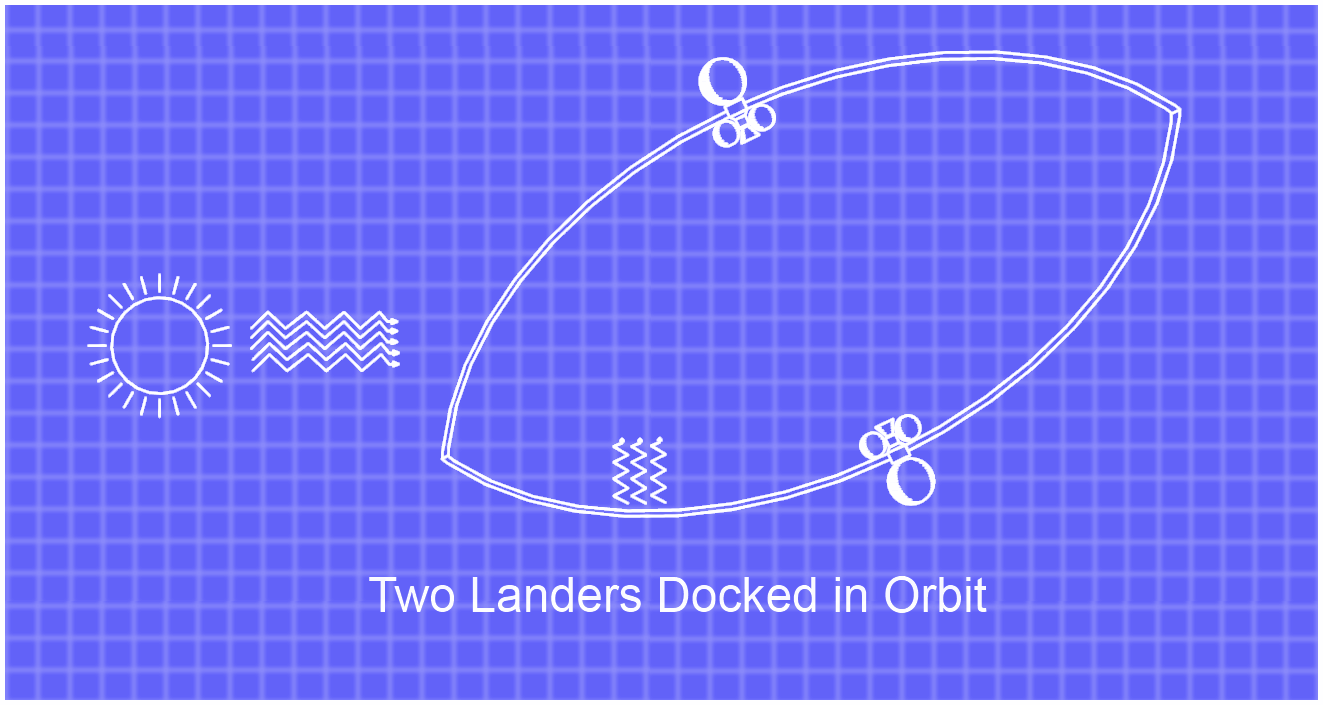
The author can provide details of this larger system which would have carbon-composite domes of 25m in diameter that would self-assemble in Earth orbit, land on the ice and return to orbit with the collected material frozen onto the underside of the dome. In orbit with full sunlight, the ice is trapped, heated and compressed into liquid water. It is electrolysed into hydrogen and oxygen with solar electric power. The lander would then be refueled and return for more ice. This system would use no more than 30% of the collected ice to refuel itself for landings and take-offs and can run a continuous operation for many years. The same 25m domes can be used as aeroshells to land on Mars and collect carbon dioxide or water ice and produce methane fuel on the surface.

The system has advantages over other methods since it does not require complicated long-term operation on the Lunar surface where extreme cold may cause problems with equipment.
The system may also be used in a forward-looking scientific program to extract samples of the Lunar ice and bring them to the future Lunar Orbiting Platform Gateway for analysis by gas spectrometer or other instruments. The astronauts would direct the operation of the landers and operate the electrolysis system on board, in preparation for a fully automated version. The system, once it is proven out, can also provide water and fuel to the LOPG and prove out ISRU methods on both Mars and the Moon. This will serve many of NASA's goals for the exploration of cis-Lunar space, the Lunar surface, the near-Earth asteroids, and Mars.
c. 2018 Marcus van Bavel (US Patent Pending)





